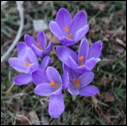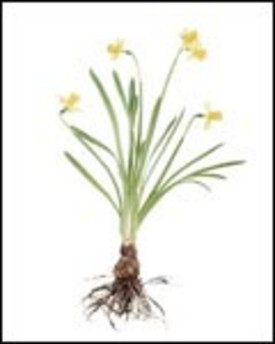 I always aim to plant a hundred or so new ones each fall, and though it sounds like a lot, it never seems to be enough when spring comes.
I always aim to plant a hundred or so new ones each fall, and though it sounds like a lot, it never seems to be enough when spring comes.
Most people know that bulbs are planted with the pointed side up at a depth of about 3 times their height. It’s worthwhile to improve the soil with compost, add superphosphate, and even good loam if necessary. Bulbs like it moist but never soggy (which causes fungus, so raise wet beds with a sand underlay for drainage).
Bulbs look better planted in clusters or "bouquets" instead of skinny rows. Instead of digging individual holes, it’s easier to excavate a bed to a depth of 7 inches or so, add the fertilizer and compost, plant the bulbs and then cover it all up.
Daffodils should go in the ground early in fall so they can establish roots before winter. Tulips are not so particular, so can be planted any time until the ground freezes.
Bulbs and the Dutch – Bulbs were brought to Holland from the Near East in about 1600 and have been grown there ever since, at first as a wild financially speculative passion, now as a profitable business. Ninety percent of all the bulbs sold are cultivated in Holland.
 Not all bulbs are the same. In general you get what you pay for. Bigger bulbs are healthier and bloom better, while bargain bulbs may be immature and will produce small or no flowers without another year or two of sun and fertilization.
Not all bulbs are the same. In general you get what you pay for. Bigger bulbs are healthier and bloom better, while bargain bulbs may be immature and will produce small or no flowers without another year or two of sun and fertilization.
Why some bulbs come back and repeat bloom year after year, and others don’t has always interested me, so I asked around when I was in Holland to see if there were any secrets to be learned from the very serious and scientific growers there. Their answer was twofold.
The First Secret – Some bulbs are genetic repeaters, such as grape hyacinths, narcissus and the early ‘species’ tulips, and these bloom again each year. The varieties with showier flowers use up all their energy flowering so don’t bloom the next year. Instead, they tend to split into smaller bulbs with foliage only. In good catalogues and stores, repeater bulbs are labelled as such or will have words like "comes back each year" or "perennial" in the descriptions. According to Dutch growers some common repeaters are:
April- Early May Repeater Bulbs
TULIP variety names are:
Kaufmannia, Greigii, Botanicals
NARCISSUS and DAFFODILS
February Gold, Tete a Tete, Jack Snipe
CROCUS
CHIONODOXA
Mid to Late May Repeater Bulbs
TULIPS
Appledorn (Darwin Hybrids), Aladdin (yellow)
NARCISSUS/DAFFODILS
Carleton, King Alfred, Geranium, Hawera, Poetaz varieties
GRAPE HYACINTHS
 The Second Secret – The second secrest of the Dutch commercial bulb farmers was fertilizer. To make the bulbs grow bigger faster, the farmers apply it twice a year, using 21-10-18, in spring and again in fall. They also spread manure on the fields in summer, which is not surprising since there are cows and sheep everywhere in Holland, next to airports, besides giant petrochemical plants and along every major highway. (And does it smell when they spread that manure!) This constant renewal of organic matter is what has kept their soil fertile during centuries of intensive cultivation.
The Second Secret – The second secrest of the Dutch commercial bulb farmers was fertilizer. To make the bulbs grow bigger faster, the farmers apply it twice a year, using 21-10-18, in spring and again in fall. They also spread manure on the fields in summer, which is not surprising since there are cows and sheep everywhere in Holland, next to airports, besides giant petrochemical plants and along every major highway. (And does it smell when they spread that manure!) This constant renewal of organic matter is what has kept their soil fertile during centuries of intensive cultivation.
In truth, I have found that even repeaters don’t repeat bloom each year for a variety of other reasons. Not planting deep enough probably causes them to split though there’s no real agreement on this point. The small non-flowering bulblets can be dug up, lined out in the vegetable garden, fertilized regularly, and in a few years they will become blooming size again. To keep them from using up all their energy flowering, the Dutch pick them for cut flowers as soon as the buds are well colored.
It is said that many bulbs need sunlight to repeat yearly, especially daffodils. Their green leaves have to produce lots of carbohydrates after blooming to store energy for the next year’s flower buds. That’s why one fertilizes.
Also if you want bulbs to bloom again, NEVER cut off the foliage until it turns yellow. Tulips turn quickly. Daffodils take a long time. To solve this unsightly mess of floppy, mottled leaves, people plant small annuals among them. Then the annual flowers fill the bed as the bulb foliage expires.
Animals in the Bulbs – Animals are the worst problem. They love to eat the fresh green shoots and buds in spring, and the grape hyacinth leaves that come up again in fall. One can spray them with ROPEL, a bitter tasting animal repellent, but then they may just dig up the whole plant. However, it’s very useful on crocus and tulips in spring. Daffodils and narcissus, being poisonous, are less likely to be eaten.
Chipmunks and squirrels dig up the bulbs and move them around, while field mice eat them underground in winter, especially tulips. Bulbs can be planted in chicken wire "baskets" underground to protect them, but that doesn’t save the tops. In spring, I have sometimes put my favorite early Red Emperor tulips in movable, above ground, circular chicken wire frames until they finish blooming.
Fungus on the Bulbs – Fungus can be a problem, especially when the soil is not well drained. Tulips are particularly sensitive to botrytis fungus or grey mold. One recommendation is to spray with a fungicide specifically for botrytis blight, every 14 days, as soon as the bud appears. Or put some sand directly under the bulb at planting time.
Bulbs in the Perennial Garden – Spring bulbs perform very well among perennials where the bulbs early bloom is welcome in the empty beds. Emerging perennial foliage then hides the unsightly, yellowing leaves of the spent bulbs. Dutch gardeners may give established bulbs just a top dressing of potash as the bulbs emerge in spring instead of the stronger 21-10-18, which the commercial growers use to bring the bulbs to blooming size.
Incidentally, if one also plants annuals among the yellowing bulb foliage, not only will they help hide the foliage, but the perennial bed will be even more glorious in August and September when the annuals come into full flower.
Credit: Mother’s Garden




























